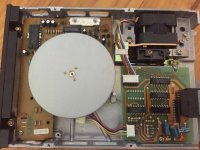This thread is more or less a continuation of this thread: http://www.vcfed.org/forum/showthread.php?51179-Broken-Apple-IIe-garbage-screen
I got a new Apple II disk controller card in the mail. Supposed to be tested and working.
When I drop it in my Apple IIe..... ? Drives do not light up and system drops straight to cursor
I tried doing the CALL-151 to monitor and C600L like the other card that I had, but the same issue!
Hex codes were the same. Apparent non-detection.
It makes no difference if the drive is connected or not.... it just drops to cursor.
As an aside, I inserted the new card into slot 7... and then tried C600L, multiple times
Every time I ran that command, the codes that came out were different each time!
Is this perhaps a lingering RAM issue with the Apple IIe that I have?
Is there some way I can fully test the RAM in the apple II, with no access to a disk drive?
Some diagnostic program I can load off the cassette line? I get KERNEL OK from the built in diagnostic... but maybe that's not enough?
I got a new Apple II disk controller card in the mail. Supposed to be tested and working.
When I drop it in my Apple IIe..... ? Drives do not light up and system drops straight to cursor
I tried doing the CALL-151 to monitor and C600L like the other card that I had, but the same issue!
Hex codes were the same. Apparent non-detection.
It makes no difference if the drive is connected or not.... it just drops to cursor.
As an aside, I inserted the new card into slot 7... and then tried C600L, multiple times
Every time I ran that command, the codes that came out were different each time!
Is this perhaps a lingering RAM issue with the Apple IIe that I have?
Is there some way I can fully test the RAM in the apple II, with no access to a disk drive?
Some diagnostic program I can load off the cassette line? I get KERNEL OK from the built in diagnostic... but maybe that's not enough?

